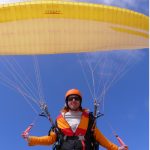How an aerofoil creates lift?
I've snuck into minute physics' studio to explain how a wing actually works.
The classic explanation
Now everyone knows that a wing generates lift due to its characteristic shape. Since air travels farther over top of the wing, it must go faster than the air underneath so that both streams meet up simultaneously at the trailing edge.
And according to Bernoulli's principle, faster flowing air exerts less pressure than the slower air beneath the wing. This pressure difference creates an upward force: lift.
Job done. Right?... Nope!
This simple explanation taught in many textbooks and classrooms has obvious problems, like how could a plane fly upside down? Some planes like the Wright brothers' had nearly flat wings.
So presumably air would travel the same speed over both sides and there would be no lift.
Plus experiments show that air streams don't meet up at the back of the wing. Air over the top goes significantly faster, reaching the trailing edge first.
Bernoulli vs Newton
So, how does a wing actually generate lift?
Well, the key is the wing must deflect air downwards.
This can be achieved using asymmetric or cambered airfoils 0r by increasing the angle of attack. Air under the wing is deflected down and by the coanda effect air above the wing is guided along its surface and down as well. Since the air is slowed and deflected down by the wing, it pushes the wing up and back: Lift, and drag.
This is in accordance with Newton's Third Law of Motion. But, hang on; if you can explain lift only using the deflection of air and Newton's laws, then the Bernoulli explanation must be completely wrong!
Well, no, air over the top of the wing does go faster than air beneath, creating a pressure difference that generates lift.
Then this Newtonian explanation is unnecessary rubbish and the original explanation was right! That's not true either.
The original explanation incorrectly assumed that air over and under the wing must reconnect at the trailing edge, and there was no mention of deflecting air down.
Each explanation, done correctly, completely accounts for the lift generated by a wing. They're just two different ways of looking at the same thing.
So next time someone brings up the standard misconception, you can tell them that explanation just doesn't fly.
This post is a transcription of the video "How does a wing actually work?"















